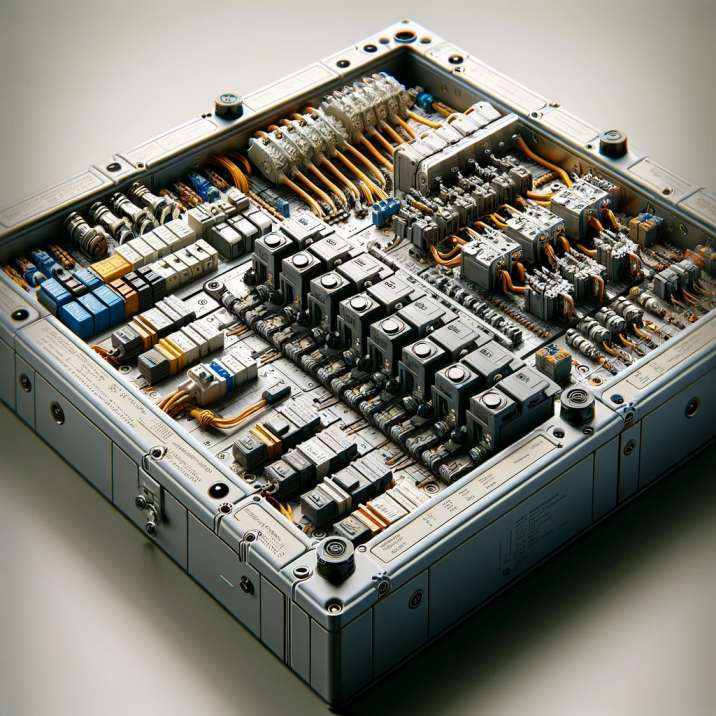Ever been plain bored at home and had a blackout make it even worse? Suddenly you’re scrambling, high and low, in search of that flashlight stashed somewhere? And as if this wasn’t fun enough, you then had to brave the house’s creepy, dark basement to check out the culprit – the breaker panel. Sound familiar? Well, today’s your lucky day because we’re about to uncover the mystery behind that gray box lurking menacingly in our home’s deepest recesses, and maybe next time it won’t seem as intimidating. Shall we begin?
What is a Panel Board?
A panel board, my friend, is like an orchestra conductor for your home’s electrical system. It keeps all appliances in tune by distributing power wherever needed. Got a toaster going flat out for your morning crumpets while you boil the kettle? Yep, the panel board’s making that happen.
History of Panel Boards
Show me anything with ‘board’ in its name that isn’t dead boring – chessboard, cardboard, or dashboard. Except for surfboards perhaps – those are cool! But surprisingly, pane boards have an exciting history too. They’re no new kids on the block either. Think 1800s when Thomas Edison was puttering around smearimg soot on glass plates! Back then they were just simple fuse boxes used to prevent our ancestors’ homes from burning down due to Edison’s newfangled ‘electricity’. Over time they’ve morphed into something much more complex and capable and don’t worry, definitely still preventing fires!
Main Components of a Panel Board
Looking inside the panel board can feel like breaking apart your grandma’s favorite radio to see how it works – thrilling but equally perplexing. There’s a flood of wires, switches, and an array of metal parts – it’s like a 3D puzzle with no map! But let’s keep it straightforward for now. It contains circuit breakers, bus bars (they’re not what you might first think!), neutral and ground bars, and the grandmaster of all – the main breaker. Each has a unique role in controlling your house’s electricity and ensuring that a fun breakfast doesn’t end up turning into a call to 911!
Types of Panel Boards
The world of panel boards is far from one-size-fits-all. There are the big guns like Main Breaker Panels that orchestrate electricity in grand mansions or yacht clubs. Then you have Main Lug Panels, quieter fellas minding their business in smaller homes or condos. There are also Sub Panels, ideal for outages because they split up power supply into manageable areas causing less disruption during repair.
Understanding Circuit Breakers
Ah, circuit breakers – the guard dogs of electrical safety in our homes. They’re everything but ‘breakers’ because their goal is to keep your power going by preventing overloads or short circuits. Just imagine them seated royally within the panel board, waiting silently for any danger to your electrical system to arise so they can jump into action!
Panel Board Sizing and Specifications
When it comes to panel boards, size does matter! And we’re talking more about fit than vanity here. A well-sized panel board means optimum usage and minimal energy wastage. It depends on the total electric load your house requires–and believe me–figuring that out feels like cracking a sudoku puzzle on steroids! And don’t get me started on volts, amperes, and watts – who says vampires are confusing?
Installation Process: Preface
Imagine setting up a fancy, flat-screen smart TV but with the added thrill of possibly electrocuting yourself – that’s what installing a panel board feels like. It goes without saying, unless you’re channeling your inner superhero vibe and willing to risk some shocks and jolts, bring in a certified electrician for this gig. They come with all the skills and bells and whistles to wire things up safely!
Installation Process: Steps Overview
Just so you don’t feel totally out of depth when your electrician starts throwing around terms like ‘mounting the enclosure’ or ‘terminal blocks’, here’s a broad brush overview of the install process. This orchestration generally involves mounting the panel, laying down conductors, connecting circuit breakers, grounding and bonding, and finally testing everything out. Now you can casually nod along when your electrician starts talking shop, giving off serious techie vibes!
Safety Precautions During Installation
Fun fact – Charlie Chaplin once worked as an electrician’s apprentice for a theater in London! Safety first was their motto back then and it applies to this day during any panel board installation. Ensuring gloves and safety glasses are worn is basic stuff. But real pro tips involve checking for de-energized circuits before working, using flash-resistant clothing (no, not your gym gear), maintaining safe distances from live parts (bit like social distancing) and always keeping nifty insulating mats handy.
Inspection and Maintenance of Panel Boards
A well-maintained panel board is like a golden retriever – loyal, steadfast and dependable. Regular grooming – we mean inspections – ensure any potential faults are kept at bay before they bare their fangs. Think hot connections, broken parts, moisture infiltration – basically stuff that sounds straight out of a suspense thriller story. But fear not! With routine care, your panel board will serve you year after year without a hitch.
Common Problems and Troubleshooting Panel Boards
It’s a full moon night and suddenly, your house plunges into darkness. Spooky, right? Well, ghosts or goblins might not be the cause but observing strange behavior from your lights and appliances could suggest your panel board is throwing tantrums. This could include tripping circuit breakers, an incessantly vibrating panel, or mystery burn marks (yikes!). Have no fear when such drama unfolds. Usually, resetting a breaker or replacing a part would solve these mysteries faster than Scooby-Doo!
The Role of Panel Boards in Residential Settings
In the great electrical symphony that is your home, the panel board leads the charge like a seasoned conductor in full swing! It choreographs every single electrical note flawlessly – from bringing your Alexa to life for a morning weather update to whipping up some night-time hot cocoa in the microwave; it’s all orchestrated with precision. The humble panel board – surely deserves an ovation for making our lives run on seamless electricity!
The Importance of Panel Boards in Commercial Buildings
If managing electricity in homes wasn’t entertaining enough, commercial settings take the cake with more energy-drunk machinery wanting power flowing through their veins! Copiers printing non-stop, elevators buzzing people around like worker bees and central heating blasting away on chilly mornings – all singing along to the tune of mighty commercial-grade panel boards. Without them holding fort,
Industrial Usage of Panel Boards
Now just hold onto your hats, because we’re venturing into the land of heavy-duty power usage – the industrial world. Here panel boards are akin to a military general ruling over an army of electricity-thirsty machinery. From giant lathes chiseling away metal blocks in factories to jazzy lighting that illuminates billboards on freeways, it’s all made possible thanks to supercharged industrial-grade panel boards. Feels like stepping into a scene from ‘Transformers’, doesn’t it?
Future Trends in the Industry
Who would’ve thought that everyone’s favorite home superhero – panel boards – would dabble with trendsetting too? Imagine having a smart panel that not only manages electricity but can also predict future energy usage or detect damage before it becomes an issue! With ever-evolving tech trends, these shiny boxes are all set to adopt ‘smarts’, making our relationship with them even more electrifying (pun intended)!
Importance of Proper Recycling or Disposal
A little known fact about our reliable pal, the panel board, is how important its retirement process is! Proper recycling or disposal of these pieces is as crucial as caring for a vintage vinyl collection. Dumping them haphazardly can lead to harmful materials leaking and causing environmental damage–an ultimate party pooper. Best trends for disposal involve professional recyclers or licensed electricians who handle them like precious treasure and ensure they bid farewell in the most eco-friendly way.
– What Are the Different Types of Panel Boards?
Panel boards come in various types such as distribution boards, switchboards, and control panels. Each serves a specific purpose in electrical systems. Distribution boards, for example, distribute power to different circuits. Switchboards, on the other hand, control the flow of electricity within a facility. It’s crucial to understand what panel board is best suited for a particular application.
Choosing the Right Manufacturer for Your Needs
In the dazzling world of panel boards shopping (who knew we’d get here?), it might feel like picking out pastries at a French patisserie – everything appears tantalizing but overwhelming. Picking the right manufacturer is all about going with the ones that have a stellar reputation, guarantee excellent performance and offer fantastic customer service. And remember, like choosing a fine wine – cheap rarely equals cheerful!
Sources and Further Reading
Feel like you’re ready to dine out on your recently enriched panel board knowledge? To feed this newfound curiosity, there are loads of professional electrician blogs, YouTube channels (well worth a watch) and good ol’ fashioned books that you can delve into for deep-dives. Who knows, panel boards might just become your new party conversation starter!
Conclusion
You made it! We’ve journeyed through the fascinating world of panel boards together – ridden circuit breakers, done the safety dance during installation and even braved the mysteries of electrical parlance. Panel boards no longer lurk as uncharted territory in our minds; instead, they’ve turned into charming charioteers of electricity serenading our homes day in and out. Feeling enlightened yet? Well, keep this electric buzz going and who knows when it might come in handy – maybe next time you’ll be leading the charge during a blackout!


